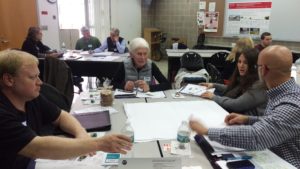At our April 16 meeting we will catch up on partner activities and provide status updates for on-going projects. We will also dedicate time on the agenda to discuss ways to link Raritan River activities to energies around the East Coast Greenway. Mike Kruimer with the East Coast Greenway Alliance, and other ECGW advocates have been invited to join in the discussion.
The meeting will be held from 10-noon in the Middlesex County Planning Offices at 75 Bayard Street, New Brunswick, NJ – 5th floor mid-size conference room.
Parking is validated for those parking on floors 5 and higher in the RWJ Wellness Parking Deck located at 95 Paterson Street, New Brunswick, NJ 08901. Be sure to bring your ticket to the meeting for validation.
Except as noted, article and photos by Joe Sapia.

Rain and fog over “Jamesburg Lake” (Lake Manalapan) on the Jamesburg-Monroe boundary, Middlesex County, on the morning of February 11, Sunday.
HEAVY RAIN: The National Weather Service reported these preliminary rainfall totals in Jersey Midlands counties for the February 10-11, Saturday-Sunday, rainfall. The numbers are not necessarily a comprehensive listing, so there could have been higher and lower totals: Burlington — 1.55 inches at Chesterfield to 4.02 at west northwest of Tabernacle; Hunterdon — 1.00 at northwest of Milford to 1.81 at Wertsville; Mercer — 1.44 west of Princeton to 2.21 west of East Windsor; Middlesex — 1.74 at Sayreville to 2.28 at East Brunswick; Monmouth — 1.27 at North Middletown to 2.82 at Howell; Ocean — 1.23 at Island Heights to 3.19 at Barnegat Inlet; and Somerset — 1.12 at Martinsville to 2.19 at Middlebush.

Manalapan Brook Overflows Its Banks
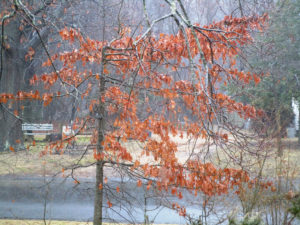
The leaves of an oak tree, genus “Quercus,” light up my front yard on a rainy day.
POOR DRAINAGE: A drainage issue flying under the radar is the clogging up of swamps — through filling them in purposely, by unintentionally clogging them by dumping leaves and other vegetative debris in them, and the overtaking of these wetlands by invasive species, such as phragmites reed grass. As the swamps clog and water is displaced, more flooding will happen.
In this Sunday, February 11, photograph of Helmetta Road, in the part of Monroe between Jamesburg and Helmetta, two problems are obvious: One, Helmetta Road (Middlesex County Route 615) passes through a low, swamp area and easily floods and, two, the surrounding swamps are clogged with phragmites. With phragmites, what is seen above ground is only an estimated one-fourth to one-third of the plant. Drive by wetlands and look at their changing nature — the overtaking by phragmites, easily identified by its tassel-like top.
Phragmites eradication projects are now underway or planned — for example, by Middlesex County Parks and Recreation at Helmetta Pond — but it is a complicated, labor-intensive, and costly undertaking. Combining that with the issue being ignored, by far not enough remediation is being done.
But something needs to be done, if not to protect the environment, then for practical anti-flooding reasons.
Look at this United States Geologic Survey website, https://nwis.waterdata.usgs.gov/nwis/peak…, for the highest flows per year on Manalapan Brook at the gauge on the Spotwsood-Monroe boundary. Over the last 60 years, four of the highest flows were in a recent 10-year period, from 2005 to 2014.
Keep covering up soil, keep filling in wetlands, and let these drainage issues get out of control. People will lose homes — think Tropical Storm Irene in 2011 and Superstorm Sandy in 2012, again in recent and back-to-back years — and be otherwise inconvenienced. Just wait….
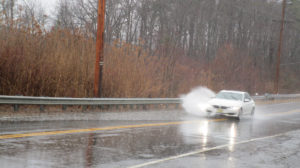
The combination of this section of Helmetta Road (Route 615) in Monroe, Middlesex County, passing through a swampy area and that area clogged with common reed grass, genus “Phragmites,” equals poor drainage.
SNOWFALL UPDATE: At Helmetta-Jamesburg-Monroe in Middlesex County, the snowfall on Saturday, February 17, was 3 inches, bringing the seasonal total to 21.5 inches. (The average seasonal snowfall at New Brunswick, Middlesex County, about 7.5 miles away, is about 26 inches. We still have about seven weeks left in the snowfall season.)
These figures for Saturday’s snow are from the National Weather Service. These are reported figures, not necessarily complete figures: Burlington County — 1.2 inches in the Eastampton and Tabernacle areas to 4.0 in Wrightstown; Hunterdon County — 4.3 in Wertsville to 9.3 in the Clinton area; Mercer County: 2.0 in the Lawrence area to 4.7 in the Hopewell area; Middlesex County — 2.0 in the Old Bridge area to 3.7 in the Cheesequake area; Monmouth County — 1.3 in Rumson to 3.0 in Colts Neck; Ocean County: .5 to 1.5, both in the Brick area; Somerset County — 3.3 to 7.4, both in the Bridgewater area; and in Pennsylvania’s adjoining Bucks County — 1.0 in Penndel to 6.4 in Springtown.
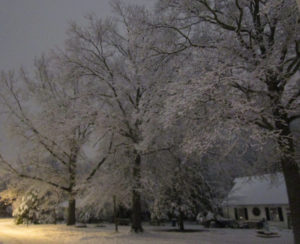
At night, as the Saturday, February 17, snow was ending, in my neighborhood in Monroe, Middlesex County.
SPRING PEEPER TREEFROGS: On the night of February 11, Sunday, I stepped outside my Monroe, Middlesex County, house and heard the nostalgic call of spring peeper treefrogs, “Pseudacris crucifer,” coming from the Manalapan Brook floodplain — kind of like sleigh bells. In February! But it was about 63 degrees on the night of a very rainy day. They are early maters — the calling likely either looking for mates or signaling territory. If you go looking for them, they will quiet as you approach and you likely will never find one. I recall seeing them only about 3 times in my 61 years. A check of my field notes going back to 1992, with only 2001 missing, shows this date as the earliest I had recorded for hearing them in a season. They likely will call and not call until we get consistently warmer weather. So, it will be interesting to see when they start calling strongly and consistently. I view peeper calls four ways: 1, these early calls; 2, regular calling; 3, late calling; and 4, an out-of-season aberration. As for their species name “crucifer,” they have a cross-like mark on their backs.

A spring peeper treefrog found in the Manalapan Brook floodplain of Monroe, Middlesex County, in 2017, March. In this photo, the X-like or cross-like mark on their upper to middle back is hard to see.
UPPER MILLSTONE RIVER EAGLE NEST: Anne Price, my fellow volunteer monitor of this nest on the boundary of Middlesex and Mercer counties, had a fabulous experience while watching the nest, where the bald eagles, “Haliaeetus leucocephalus,” are sitting on an egg or eggs. She watched a mature eagle flying with an immature. So, there is at least one immature in the immediate area of the nest. We expect the egg/s to hatch in late February or early March. We are not releasing the exact location of the nest to protect it because eagles, as breeders, are considered “endangered,” or in immediate peril, in New Jersey and, in general, are considered “threatened,” meaning if conditions deteriorate, they could become “endangered.”
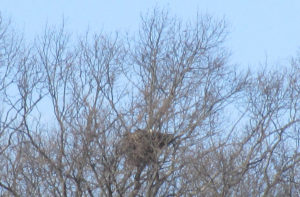
The head of a bald eagle pokes out of the Upper Millstone River nest. The eagles are sitting on an egg or eggs.
COASTAL PLAIN AND PIEDMONT: As I have noted previously, the Jersey Midlands is composed of two geologic regions: the rolling hills and rocky terrain of the Piedmont to the west and the generally flat land of the Coastal Plain to the east. (I also like to break up the Coastal Plain into the Inner and Outer.) For our purposes here, let us talk of the Piedmont with its soil of red shale and the Inner Coastal Plain with its gravelly soil. I was driving the other day in South Brunswick, Middlesex County, and noticed piles of dirt, basically displaying these two types of soil. In the following photograph, the red shale of the Piedmont is to the far left, the gravelly soil of the Inner Coastal Plain to the far right:
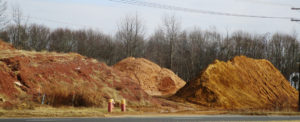
‘SPOTSWOOD LAKE’: On the flat-terrain Coastal Plain, there are few, if any, natural bodies of water. Instead, the water bodies are human-made, either by digging a depression or by damming a waterway. The approximately 60-acre “Spotswood Lake,” properly known as “DeVoe Lake” or “Mill Lake,” is an example — formed by the damming of Manalapan Brook shortly before it joins Matchaponix Brook on the Spotswood-Old Bridge boundary in Middlesex County to form the South River.
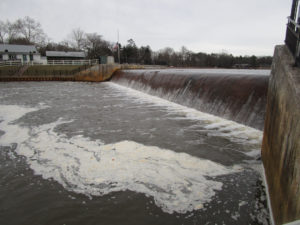
This dam holds back Manalapan Brook, forming Spotswood Lake.

This photograph of “Spotswood Lake” takes in a lot: wildlife (Canada geese, “Branta canadensis”), religion (a cross), patriotism (the American flag), and history (in the background, an old pump house to the right of the residential house).
BROKEN PITCH PINE: A branch on the pitch pine, “Pinus rigida,” in my backyard in Monroe, Middlesex County, was leaning. When I checked it, I saw that it was damaged. So, I chopped it off. I could put it out on the road, where the township picks up vegetative waste. Instead, I put it to use on-site, adding it to my backyard wildlife brush pile — often a haven for birds and presumably other wildlife. I try to keep my yard as a quarter-acre farm, discarding something in one place and using it elsewhere on the property.
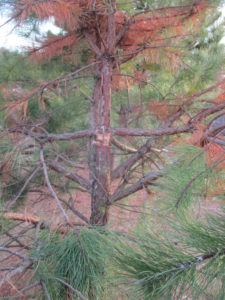
The broken branch area of the pitch pine.
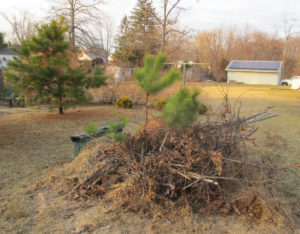
Notice the pitch pine in the background. It has a missing section. Well, there is the missing section, now in my wildlife brush pile in my backyard.
ATLANTIC OCEAN TEMPERATURES: The Atlantic Ocean temperature along the New Jersey coast was running at about 39 to 41 degrees on the February 17-18 weekend.
SUNRISE/SUNSET: From Sunday, February 18, to Saturday, February 24, the sun will rise about 6:40 to 6:45 a.m. and set 5:35 to 5:45 p.m. From Sunday, February 25, to Saturday, March 3, the sun will rise about 6:30 to 6:35 a.m. and set about 5:45 to 5:50 p.m.
FULL MOON: The next full moon is March 1, Thursday, the Full Lenten Moon.
WEATHER: The National Weather Service forecasting office serving the Jersey Midlands is at http://www.weather.gov/phi/.
MARJORY STONEMAN DOUGLAS: When I heard of the Wednesday, February 14, school shooting in Florida that took 17 lives, I thought of the school’s name: “Marjory Stoneman Douglas High School.” I hope Douglas’s name is not predominantly associated with the place where 17 murders took place; Douglas was an acclaimed environmentalist, author of the seminal 1947 “The Everglades: River of Grass.” Her name deserves better.
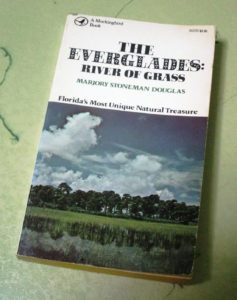
My copy of Marjory Stoneman Douglas’s classic book, “The Everglades: River of Grass.”
UPCOMING:
March 3, Saturday, 10 a.m. to 1:30 p.m., Somerset County — Deer Management Symposium at the Elks Lodge, 354 Route 518, Montgomery, free. Different stakeholders are to discuss deer management. More information is available at info@sourland.org.
March 10, Saturday, 11 a.m. to 12:30 p.m., Ocean County — Science Saturday, talk on striped bass management and fishing by Brendan Harrison, a New Jersey Division of Fish and Wildlife fishing technician,at the Long Beach Island Foundation of Arts and Sciences, 120 Long Beach Boulevard, Loveladies, 08008, $5 for non-members. More information at telephone 609-494-1241.
March 10, Saturday, 9 a.m. to 4 p.m., Atlantic County: 29th Annual Pinelands Short Course at Stockton University, 101 Vera King Farris Drive, Galloway, 08205. More information at https://stockton.edu/continuing-studies/conferences.html.
March 11, Sunday, 11 a.m. to 4 p.m., Atlantic County: 13th Annual Lines on the Pines, a Pine Barrens day of the written word, spoken word, art, and the performing arts at Stockton University, 101 Vera King Farris Drive, Galloway, 08205. More information at http://www.linesonthepines.org/linesonthepines.html.

A scene from the 2016 Lines on the Pines event. This is a great event, one that I try to attend every year.
AS THIS FICKLE WEATHER WEEK ENDS: Sun, rain, and snow. Cold and warm temperatures. Soon, gardening and farming will be here. Until then….
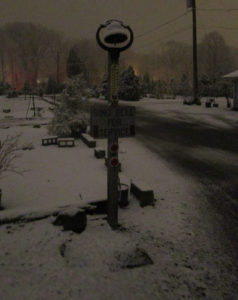
On this snowy night of Saturday, February 17, the bell will have to await its time to be rung at Krygier’s Nursery in South Brunswick, Middlesex County.
Joe Sapia, 61, is a lifelong resident of Monroe — in South Middlesex County, where his maternal family settled more than 100 years ago. He is a Pine Barrens naturalist and an organic gardener of vegetables and fruit, along with zinnias and roses.
He draws inspiration on the Pine Barrens around Helmetta from his mother, Sophie Onda Sapia, who lived her whole life in these Pines, and his Polish-immigrant grandmother, Annie Poznanski Onda.
He gardens the same backyard plot as did his Grandma Annie and Italian-American father, Joe Sr. Both are inspirations for his food gardening. Ma inspires his rose gardening.
Joe is a semi-retired print journalist of almost 40 years. His work also is at @JosephSapia on Twitter.com, along with Facebook.com on the Jersey Midlands page.
Copyright 2018 by Joseph Sapia
With grant support from the Middlesex County Office of Arts History, the Lower Raritan Watershed Partnership and coLAB Arts will implement the first component of the #lookfortheriver Public Art Program in New Brunswick’s Boyd Park in Summer 2018. The grant will allow for engineering and construction of a footing (the base) for a new public art piece for New Brunswick’s Boyd Park. The creative work to be installed at that site will serve both environmental/watershed awareness and cultural/community engagement purposes for the Raritan River waterfront at that site. Grant funding has been provided by the Middlesex County Board of Chosen Freeholders through a grant provided by New Jersey State Council on the Arts / Department of State.
The #lookfortheriver Public Art Program is a component of the LRWP’s #lookfortheriver watershed restoration campaign, which is designed to encourage community members to “look” for buried streams using landscape cues and historical research. #lookfortheriver is a package of actions communities can engage in around flood resilience and environmental restoration. The LRWP will be rolling out aspects of the #lookfortheriver campaign through 2018 and 2019.



Except where noted, article and photos by Joe Sapia
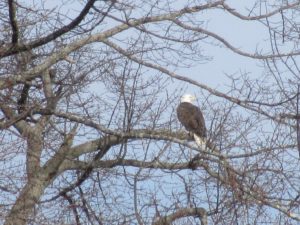
A bald eagle perched in a tree near its “Upper Millstone River” nest on the boundary of Middlesex and Mercer counties.
UPPER MILLSTONE RIVER EAGLE NEST: As the state Department of Environmental Protection monitors of the nest, Anne Price and I have been watching the pair of bald eagles, “Haliaeetus leucocephalus.” By week’s end, they were still in pre-nesting mode – flying in courtship, perched near each other near the nest, perched together on the nest. Stay tuned, there should be an egg or eggs during the week of January 28. Because bald eagles are a jeopardized species in New Jersey – “endangered,” or under imminent threat as a nester, and “threatened,” or could become “endangered” if conditions persist, in general – we are being discreet in identifying the location of the nest. (In the 2017 state eagles report, http://www.state.nj.us/dep/fgw/ensp/pdf/eglrpt17.pdf, this nest is listed as No. 184, “Upper Millstone.”)
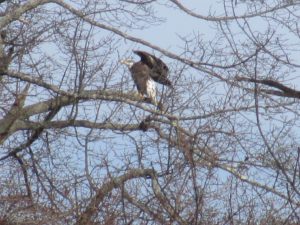
The eagle, spreading its wings, on a tree near the nest.
NORTHERN HARRIERS: I love northern harriers, “Circus cyaneus,” flying low above fields, searching for mammals to eat. They glide eloquently, putting on quite a show. This week, I was watching them on the Monroe-Cranbury boundary, Middlesex County – one at the wetlands mitigation bank at Cranbury Station, then around the wetlands mitigation bank at Wyckoff’s Mills. I did not get a good look at the Cranbury Station “marsh hawk,” but watched the Wyckoff’s Mills one for several minutes, flying back and forth, seemingly unbothered by me. The glimpse I got of the Cranbury Station harrier suggested it was a male, because it looked to be light-colored. The Wyckoff’s Mills harrier was a female – brown in color. Harriers, whether male or female, are easy to identify – flying within feet of the ground, sleek-bodied, having a white rump patch.
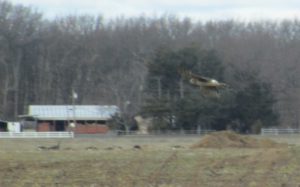
A northern harrier flies across farmland in at Wyckoff’s Mills on the Cranbury, Middlesex County, side of the road. Brown in color means it is a female. Notice the white rump patch females and males both have.

The female northern harrier flies above the wetlands mitigation bank on the Monroe side of the road at Wyckoff’s Mills, Middlesex County.

The female northern harrier flies on the Monroe side of the road at Wyckoff’s Mills, Middlesex County.
BLACK SQUIRRELS: If you want to see black squirrels, check out Princeton or Cranbury. Several years ago, I heard a story, although I do not know if it is true, that someone from Cranbury went to Princeton, trapped some black squirrels, and brought them to Cranbury. Actually, black squirrels are just a black phase of a gray squirrel, “Sciurus carolinensis.” Gray squirrels have no gray hairs — only white, black, and brown with the combination giving them a varied appearance.
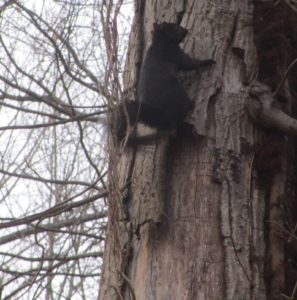
A black-phase gray squirrel in the woods between Wyckoff’s Mills and Cranbury Station in Cranbury, Middlesex County.
DEER IN THE DAYTIME: Twice in one day, I saw deer, “Odocoileus virginianus,” seemingly unbothered in the daytime in areas with a lot of human traffic. At noon, I saw one in a residential area on Riva Avenue, East Brunswick, Middlesex County. Then, 3-1/2 hours later, one was in a lawn area of Thompson Park, Monroe, Middlesex County. I thought this daytime lack of fear of these deer was brazen.
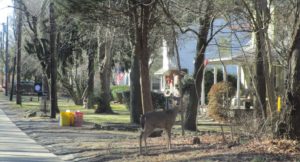
The deer on Riva Avenue in East Brunswick, Middlesex County.
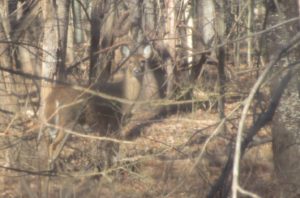
The East Brunswick deer fled me, then checked me out from the relative safety of the woods.
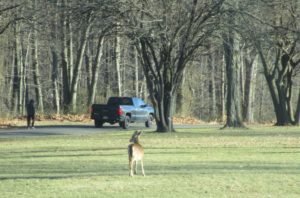
A deer in Thompson Park in Monroe, Middlesex County
ROBINS, A SIGN OF SPRING?: Some may think of robins, “Turdus migratorius,” are a sign of spring. But, actually, they are around in the winter. Perhaps more in the woods this time of year because of berries as a food source. Then, as it warms, with insects and worms becoming available, in our yards where we readily see them. But a little group of robins popped into my yard, across from woods, this week. (I have this affection for robins, because, I think, it was the first bird I learned to identify as a child.)
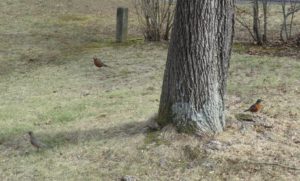
Robins in my front yard in Monroe, Middlesex County.
BIRDS, STARLINGS: Recently, I have noticed flocks of starlings, “Sturnus vulgaris.” The photograph shows them on farmland in Monroe, Middlesex County. (They are non-native, brought from Europe to North America in the 1800s and, now, naturalized here.)
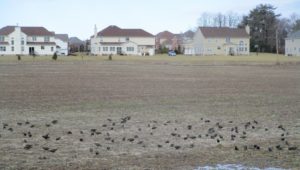
A flock of starlings on farmland in Monroe, Middlesex County.
YARD BIRDS: I was able crank off photographs of a white-throated sparrow, “Zonotrichia albicollis,” in one of my favorite bird-watching areas – through my living room window in Monroe, Middlesex County.
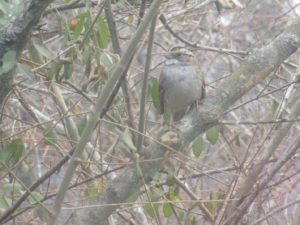
A white-throated sparrow in my front yard in Monroe, Middlesex County.
STINK BUGS: With the cold weather, I have an occasional brown marmorated stink bug, “Halyomorpha halys,” invading my house. I exterminate them. Their stink is not bad – more an earthy organic smell than a nauseating one. But they are highly invasive non-natives that could be devasting to farming. They have been documented for only about 20 years, believed to have arrived from East Asia to the Allentown, Pennsylvania, area via cargo. See https://njaes.rutgers.edu/stinkbug/.
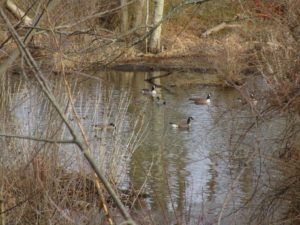
Canada geese, “Branta canadensis,” and mallard ducks, “Anas platyrhynchos,” along the Millstone River in East Windsor, Mercer County.
JERSEY MIDLANDS PRECARIOUS LOCATION: The beautiful Jersey Midlands are situated precariously between two major metropolitan areas, New York City and Philadelphia, and in the heart of the Boston-to-Richmond megalopolis. So, we are under development pressure. But, sometime, when we see our natural world beauty, we may forget how close we are. Reminders are the ongoing development (and destruction of the Midlands); traffic on the New Jersey Turnpike, Garden State Parkway and elsewhere; jets passing overhead.

A view of the New York City skyline – the Freedom Tower, center, and the Empire State Building, just to the right of the utility line tower – through the eye of a point-and-shoot camera about 35 miles away from Redmond’s Hill at Thompson Park in Monroe, Middlesex County.
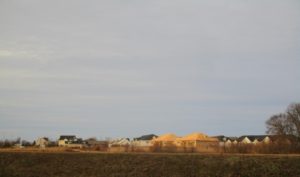
Here is an example of that development – in what I grew up calling “The Farms” of Monroe, Middlesex County.
PEGGY RENNER, ARCHERY CHAMP: I stumbled upon an obituary for Peggy Renner, who died this week. She and her family ran an archery-outdoors store in the Jamesburg-Monroe area for years. A salute to Peggy. Peggy’s obituary, http://www.legacy.com/obituaries/mycentraljersey/obituary.aspx?n=margaret-w-renner&pid=188001769&fhid=27060.
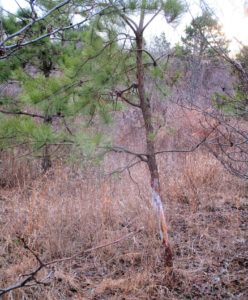
A deer rub of a male deer, “Odocoileus virginianus.” Bucks will rub the velvet off their antlers because they are hormonal and ready to mate, along with declaring their mating turfs. This is a pretty big rub, so there must be a pretty big buck around the Wyckoff Mills wetlands bank on the Monroe-Cranbury boundary, Middlesex County.
SWEET GUM TREE: Seeds from the pods of sweet gum, “Liquidambar styraciflua,” are a food for wildlife. This Internet site shows artsy uses for the seed pods, https://www.pinterest.com/beckyblue65/sweetgum-tree-seed-pods/.
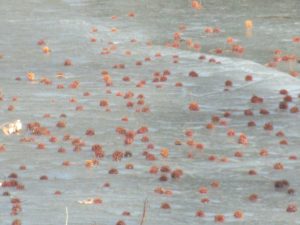
Seed pods of the sweet gum tree dot the ice of Devil’s Brook on the boundary of Plainsboro and South Brunswick, Middlesex County.
TURKEY VULTURES: We may note turkey vultures, “Cathartes aura,” flying V-winged or eating roadkill. They are a common bird. This week, I caught two interesting photos, one of them on a roadkill, the other in silhouette illustrating their look.
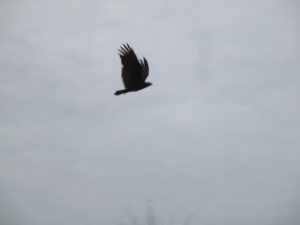
A turkey vulture. From Cornell University’s All About Birds website, “…They have long ‘fingers’ at their wingtips and long tails that extend past their toe tips in flight” — both evident in the photograph.
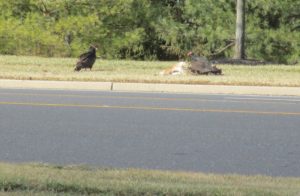
Turkey vultures on a deer carcass on Route 535 in Cranbury, Middlesex County.
SKY VIEWS: This week’s sky photographs are from Middlesex County – Cranbury and Monroe.

A farmland scene between Applegarth and Wyckoff’s Mills in Monroe, Middlesex County.

Again, a farmland scene between Applegarth and Wyckoff’s Mills in Monroe, Middlesex County.
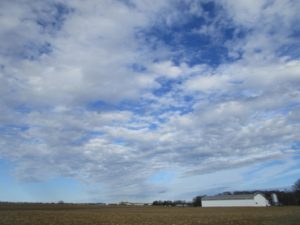
And, again, a farmland scene between Applegarth and Wyckoff’s Mills in Monroe, Middlesex County.

Wyckoff’s Mills farmland in Cranbury, Middlesex County.

Looking toward Applegarth in Monroe, Middlesex County.

At the Dey Farm historic site in Monroe, Middlesex County.

At Thompson Park in Monroe, Middlesex County.

At Saint James Cemetery in Monroe, Middlesex County.

Farmland in Cranbury, Middlesex County.
ATLANTIC OCEAN TEMPERATURES: The Atlantic Ocean temperature along the New Jersey coast is running at about 35 or 36 degrees.
WEATHER: The National Weather Service forecasting office serving the Jersey Midlands is at http://www.weather.gov/phi/.
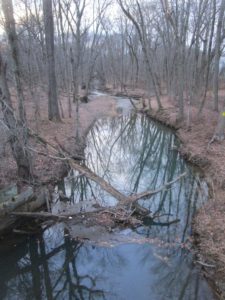
Cranbury Brook, here at Cranbury, Middlesex County, is part of the Raritan River watershed. Cranbury Brook runs from the Route 33 area at Millstone and Manalapan in Monmouth County.
SUNRISE/SUNSET: For Sunday, January 28, to Saturday, February 3, the sun will rise about 7:05 a.m. to 7:10 a.m. and set about 5:10 p.m. to 5:20 p.m.
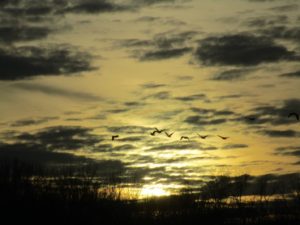
Canada geese flying at sunset on the border of Cranbury and Monroe, Middlesex County.
Joe Sapia, 61, is a lifelong resident of Monroe — in South Middlesex County, where his maternal family settled more than 100 years ago. He is a Pine Barrens naturalist and an organic gardener of vegetables and fruit, along with zinnias and roses. He draws inspiration on the Pine Barrens around Helmetta from his mother, Sophie Onda Sapia, who lived her whole life in these Pines, and his Polish-immigrant grandmother, Annie Poznanski Onda. He gardens the same backyard plot as did his Grandma Annie and Italian-American father, Joe Sr. Both are inspirations for his food gardening. Ma inspires his rose gardening. Joe is a semi-retired print journalist of almost 40 years. His work also is at @JosephSapia on Twitter.com, along with Facebook.com on the Jersey Midlands page.
Copyright 2018 by Joseph Sapia
**Please note date change**
For our March 12 general meeting, in recognition of the 2018 World Water Day theme of “Nature for Water,” we have asked Rutgers Professor JeanMarie Hartman to present on “The Role of Forests as Green Infrastructure.” As part of this presentation, Professor Hartman will provide an overview of a proposal to reforest vacant lots in Perth Amboy as a way to manage combined sewer overflow events.
The design suggestions will be compared to current best management standards and practices. Discussion will also elucidate several points regarding the relationships between human and natural systems such as resource conservation, habitat restoration and creation, and urban ecology.
The meeting will be held from 10-noon in the Middlesex County Planning Offices at 75 Bayard Street, New Brunswick, NJ – 5th floor mid-size conference room.
Parking is validated for those parking on floors 5 and higher in the RWJ Wellness Parking Deck located at 95 Paterson Street, New Brunswick, NJ 08901. Be sure to bring your ticket to the meeting for validation.
For more information contact Heather: hfenyk AT lowerraritanwatershed DOT org
Please join us for our May visual habitat assessment training with the LRWP and WMA9 Americorps Watershed Ambassador Rob Hughes! (Here’s more on the LRWP’s water quality monitoring programs).
This FREE training on Saturday May 5 will run from 9 AM – 1 PM at the Middlesex High School, located at 300 John F Kennedy Dr, Middlesex, NJ 08846
We will start the morning with a lecture indoors, and then get out in the field to test our knowledge of streams and stream habitat.
Please wear clothing and footwear that you don’t mind getting wet and dirty.
RSVP required, E-mail Rob Hughes: wsamb@raritanbasin.org

~VOLUNTEERS NEEDED~ Please join the LRWP, our Americorps Watershed Ambassador and community partners including Friends of Mile Run Brook, Greater Brunswick Charter School, Esperanza Neighborhood Project, the New Brunswick Environmental Commission, Elmwood Cemetery and the New Brunswick Department of Public Works for a multi-site clean-up of Mile Run Brook, culminating in a community celebration in Boyd Park!
WHAT: a clean-up of Mile Run Brook, followed by a community picnic and celebration
WHEN: Saturday May 12
9:00 AM to noon – clean-up of multiple sites.
12-1:30 pm community gathering / picnic in Boyd Park.
WHERE: Multiple sites in New Brunswick
Site 1: Friends of Mile Run Brook / Corner of Hamilton Street and Woodbridge Street
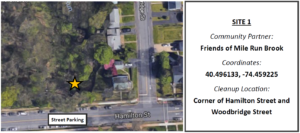
Site 2: Esperanza Neighborhood Project / Corner of French Street and Sandford Street

Site 3: Greater Brunswick Charter School (closed group)
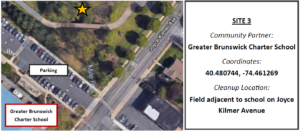
Site 4: Elmwood Cemetery / Entrance at Commercial Avenue
Please wear closed toe shoes and clothes you are willing to get wet and dirty. Gloves and bags will be provided!
WAIVERS
5.12.2018 MRB clean-up waiver, English
Permission and rights granted to LRWP to record and use image and voice, English
For more information
Heather: hfenyk AT lowerraritanwatershed DOT org
or Americorps Watershed Ambassador Rob Hughes: wsamb AT raritanbasin DOT org
Article by Quentin Zorn
My name is Quentin, and I am a junior at Rutgers studying environmental policy. Over the course of this semester, I have been interning with the Lower Raritan Watershed Partnership and have had the opportunity to work on a wide variety of projects relating to water quality issues. I participated in many stream cleanups, attended many exciting events such as the Raritan River Festival, got to contribute to several long-term art projects and learned a lot along the way. This experience has not only taught me a lot about watershed management, but also has broadened my way of thinking and strengthened my passion for combating environmental issues.

One of the more exciting projects I was able to participate in was teaching kids from the Plainfield Youth Center about water quality and watershed management, and to work on an art project with them. This was part of the Lower Raritan Watershed Partnership’s Project WADES Environmental Education curriculum. We started off by taking the kids to a nearby stream and training them in visual habitat assessments and how to notice what kinds of things can impair stream quality, such as nearby roads, maintained lawns and lack of riparian cover. We got to help build a foundation with these kids at a young age, which will help them understand and care about water quality issues as they grow up.
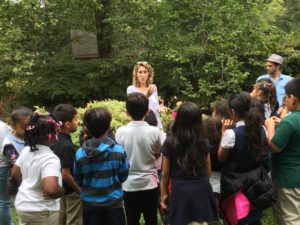
The art project we worked on with the kids was a lot of fun and interactive. Each kid selected a piece of trash found at a cleanup in the Lower Raritan Watershed, and then held that piece of trash in a container, which we would then fill with an algae-based mold called alginate.

The finished products were a bunch of unique sculptures of hands holding the trash.

When I was working on my own on this internship, I got to explore and contribute to several different datasets. I worked on a master database of every municipality in the Lower Raritan Watershed that contained a wide variety of information on each town’s environmental and development plans. I also worked with data from the New Jersey Department of Environmental Protection on different industries that have permits to pollute into the Raritan River, and I helped make this data more coherent and complete. This helped me understand what kind of information is important when considering water quality, and also my contributions helped make more complete and meaningful logs of data. It was really satisfying to see all this information come together and fulfilling to know that the public can access this data and learn what is going on in their watershed.

There were many cleanups of streams in the watershed throughout the duration of my internship, and I participated in as many as I could. The cleanups were far more rewarding than I anticipated them being. Arriving at any given cleanup gave me a feeling of hopelessness when I would see how much trash there was. I would think, “we can make this a little better, but it’s still going to be in a bad condition.” Every single cleanup I was surprised by how good of a job everyone did, and how great the area looked when we left. Seeing all of the trash piled up in the end was always shocking but felt good to have gotten it all out of the ecosystem.
On November 17 the Lower Raritan Watershed Partnership joined with NOAA to co-host a day-long workshop: “Introducing Green Infrastructure for Coastal Resilience”. This workshop, designed for planners, engineers and municipal leaders not yet familiar with GI for coastal resilience, brought in more than 50 participants from the Lower Raritan Watershed and throughout New Jersey. It was a great event!
Workshop participants brainstorm ways to implement Green Infrastructure in their communities
Many thanks to everyone who joined us for the workshop, with special thanks to our speakers: Lauren Long (NOAA), Toby Horton & Jeremiah Bergstrom (Rutgers Cooperative Extension), John Trucsinski (The Nature Conservancy), Linda Weber (Sustainable Jersey) and Carter Craft (Consulate General of the Netherlands).
Tobiah Horton (Rutgers Extension), Lauren Long (NOAA) and Carter Craft (Consulate General of the Netherlands) discuss local resilience responses
The workshop was timed to coincide with the 5th anniversary of Superstorm Sandy. We saw this anniversary as an opportune moment to reflect on successes in implementing GI thus far, as well as to frame challenges, solutions and opportunities for future GI interventions. Of course this work is just beginning. The LRWP, NOAA and Rutgers Marine Sciences are discussing how to continue the conversation in 2018. Stay tuned! For now, please see conference handouts, presentations, and additional resources below.
Participant Agenda:
Conference Handouts:
Presentations:
Notes:
Additional Resources:
Article and photos by Joe Sapia
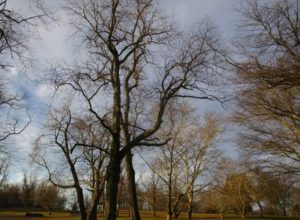
Soft morning sunlight contrasts with threatening skies at the high ground of Thompson Park in Monroe, Middlesex County.
A popular winter activity for generations at Thompson Park is sledding from the high ground toward the low ground around “Jamesburg Lake” (properly Lake Manalapan). The 30-acre lake is formed by the damming of Manalapan Brook at Jamesburg. Remember, there are few, if any, natural bodies of water on the Coastal Plain.

Sledding at Thompson Park in Monroe, Middlesex County, via my 2001 folk art Christmas card.
SNOWFALL: The Saturday, December 30, snowfall of 1.0 inch at my house in the part of Monroe between Helmetta and Jamesburg, Middlesex County, brought the season’s total to 9.0 inches. The seasonal average for New Brunswick, Middlesex County, about 7 miles away, is 25.8 inches. Elsewhere in the Midlands, according to the National Weather Service, with these readings based on what had been reported by reliable spotters at the end of the snowfall and perhaps not comprehensive: Burlington County: a high of 2.5 inches at Florence to a low of 1.5 inches at Moorestown; Hunterdon County: 1.0 inch in Lebanon to .8 inches at Whitehouse Station; Mercer County: 3.2 inches in Hamilton to 2.5 inches in Ewing; Monmouth County: 2.8 inches in the Howell area to .9 inches in Shrewsbury; Somerset County: 1.0 inch in Basking Ridge to .8 inches in Bridgewater; Ocean County: 3.3 in Jackson to 1.5 inches in Toms River.
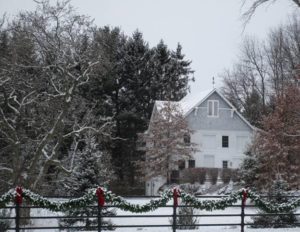
Main Street in Cranbury, Middlesex County, in the Saturday, December 30, snowfall.
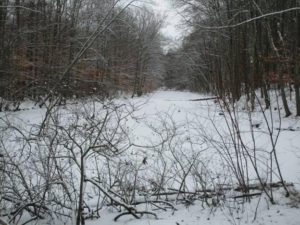
Iced-over and snow-covered Devil’s Brook on the boundary of Plainsboro and South Brunswick, Middlesex County.
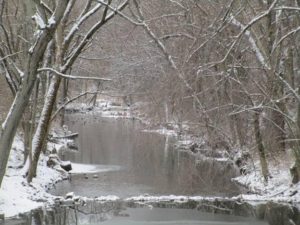
Cranbury Brook as it drains Brainerd Lake (“Cranbury Lake’) in Middlesex County.
SAFE ICE: This time of year, and especially in the hard freeze the Jersey Midlands is in the midst of, we may be tempted to walk out on ice or go skating on it. Be careful! My rule of thumb is the ice must be at least 4-inches-thick. But various factors could come into play, such as warming temperatures, honey-combing, and running water. So, additionally, I look for crystal clear ice or blue-white ice. I am careful of melting ice, snow insulating ice, channels that may run through bodies of water, and fragile ice where water meets land or vegetation.
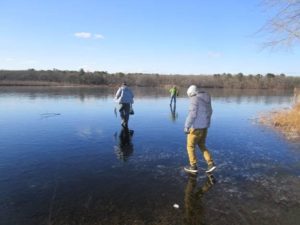
Anglers on an iced-over Helmetta Pond.
ICE SAFETY: If ice is breaking underneath, displace your weight by lying flat. For would-be rescuers, follow this order: throw (a line or flotation device), row (a boat to the person), go (yourself only as a last resort). Probably the soundest advice is to immediately seek help from expert rescuers.
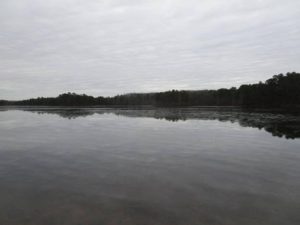
Prospertown Lake in Jackson, Ocean County. The lake is at the northern extreme of the main Pine Barrens.
SWAMP-WALKING: With the sub-freezing high temperatures for an extended period, this is what I look for — a good freeze of the swamps, allowing access to otherwise difficult places to get to. I love swamps!
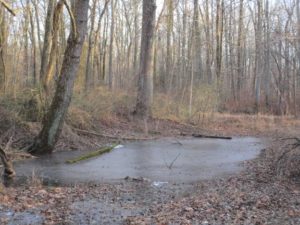
An iced-over wet area in the Manalapan Brook floodplain in Monroe, Middlesex County.
SWAMP-WALKING, No. 2: I started off into the woods across the street from my house – in the Pine Barrens of Monroe, Middlesex County – to do some swamp-walking in the Manalapan Brook floodplain. I did do some, but I got sidetracked when I noticed the abundance of winterberry, genus “Ilex.” I did not get around to making a Christmas wreath or swag, which I decorate with winterberry, but I wound up gathering winterberry to display on its own. I came home with a nice bundle. (To conserve, I broke only one branch from each selected bush.)

Winterberry from the swamp hardwood forest of the Manalapan Brook floodplain on display on my antique kitchen table.
SNOW GEESE: I finally saw some snow geese, “Chen caerulescens,” down from the Arctic as I was driving along the Mercer County-Middlesex County boundary on the border of East Windsor, Cranbury, and Monroe. They were easy to identify by their white bodies and black-tipped wings. There were only a few, rather than a flock. I took a few minutes to see if they were joining a flock on some farmland, but I was going to work and had limited time, finding nothing in my quick search.
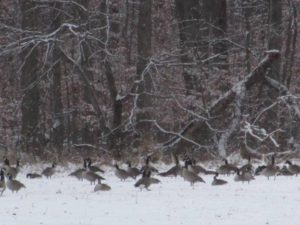
Canada geese, “Branta Canadensis,” is a snow-covered field in South Brunswick, Middlesex County.
ATLANTIC OCEAN TEMPERATURES: The Atlantic Ocean temperature at Sandy Hook on December 30-31 weekend ranged from about 30 to 35 degrees.

A quiet December Atlantic Ocean beach, looking from Avon-by-the-Sea to Asbury Park, Monmouth County.
MOON: The next full moon, the Full Moon After Yule, is January 1, New Year’s Day.

The near-full moon over the swamp hardwood forest of the Manalapan Brook floodplain in Monroe, Middlesex County.
SUNRISE/SUNSET: For Sunday, December 31, to Saturday, January 6, the sun will rise about 7:20 a.m. and set about 4:35 to 4:40 p.m. For Sunday, January 7, to Saturday, January 13, the sun will rise about 7:20 a.m. and set about 4:45 to 4:50 p.m.
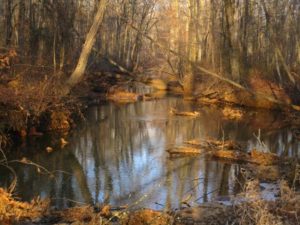
Soft sunlight on Manalapan Brook in Monroe, Middlesex County, as it flows toward Helmetta and Spotswood, also in Middlesex County.
Joe Sapia, 61, is a lifelong resident of Monroe — in South Middlesex County, where his maternal family settled more than 100 years ago. He is a Pine Barrens naturalist and a gardener of organic vegetables and fruit, along with zinnias and roses. He draws inspiration on the Pine Barrens around Helmetta from his mother, Sophie Onda Sapia, who lived her whole life in these Pines, and his Polish-immigrant grandmother, Annie Poznanski Onda. He gardens the same backyard plot as did his Grandma Annie and Italian-American father, Joe Sr. Both are inspirations for his food gardening. Ma inspires his rose gardening. Joe is a semi-retired print journalist of almost 40 years. His work also is at @JosephSapia on Twitter.com, along with Facebook.com on the Jersey Midlands page.
Copyright 2017 by Joseph Sapia


























































